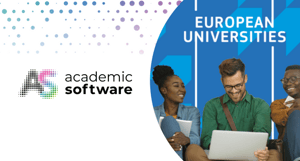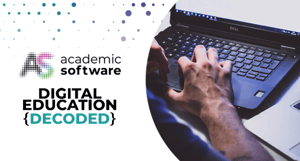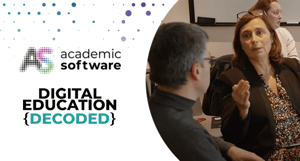CEU Cardenal Herrera University face-to-face training transformation
Face-to-face training in the digital age
The Rector of the CEU Cardenal Herrera University in Spain speaks in his welcome of it being an "international university". He does not exaggerate. Whilst CEU Cardenal Herrera University is a small university with 9,000 undergraduate students and 2,000 postgraduate students, of those, 4,000 students were not born in Spain. The university attracts international students by highlighting its "academic model oriented towards excellence and the comprehensive training of our students". In other words, CEU Cardenal Herrera University, emphasises the value of face-to-face training.
The role of the teacher in face-to-face training
This emphasis on face-to-face training may seem surprising in an era when digital technologies increasingly define the future of education. However, in this episode of our Digital Education Decoded series, Gerardo Antón Fos, vice chancellor for Academic Organisation and Teaching Staff at CEU Cardenal Herrera University, highlights the role of the teacher in the classroom, arguing that face-to-face education is more important than ever.
Face-to-face training, he argues, enables the key aspects for the development and training of a student to be enabled – particularly in terms of verbal, physical, and visual communication. The interaction between students, facilitated by the teacher, is also much richer in face-to-face environments than in remote ones (even when they may be synchronous).
The pandemic has introduced us to new digital environments in which we can learn, interact with our colleagues, work remotely and asynchronously. But face-to-face training guided by a teacher who communicates well still has its place. I asked Gerardo if he considered the MOOC platforms (Coursera, Udemy, etc.) or YouTube (with its short videos talking about practically anything) competition for the university. His answer is clear: certainly not.
The limitations of digital learning
Having educational material readily available at the click of a button is not enough for learning. Ease of access to information helps to increase the quality of debate in different areas of public interest such as science, philosophy, politics and culture. However, huge amounts of information, injected at high speed, in a disjointed manner and without the necessary time for personal digestion of the data received, can lead to more confusion than learning.
Learning is a complex process, in which one must understand what is being studied, connect with previous ideas, memorise information, and arrange the learning elements in the most appropriate order for later recall. And, above all, people need to be involved in collegial learning.
In some of these elements, technology not only does not always help, but we know that there is a point at which it may become detrimental to learning. The Organisation for Economic Co-operation and Development (OECD) and the World Bank have pointed out in several reports over a number of years that bringing technology into the classroom as a goal of education without considering how it is used can even be detrimental.
The significance of teachers and classrooms
For all the above reasons, CEU Cardenal Herrera University does not consider itself a hybrid university. It does, however, consider itself a university where the diversity of a varied and international group of students means learning is enriched by the very composition of the group. In a society that is complex and changing, universities need to adapt to new realities, to understand the needs of society and to propose actions for social transformation. These include training and research, two of the levers that the university uses to contribute to the world.
Technology is an extension and sometimes an enhancement of the perceptual system. The Internet has managed to fulfil the old dream of the Enlightenment Encyclopaedia; to relate and connect all of humanity's knowledge. But in this ocean of knowledge and data, the relevance of the teacher and the classroom are more important than ever.


